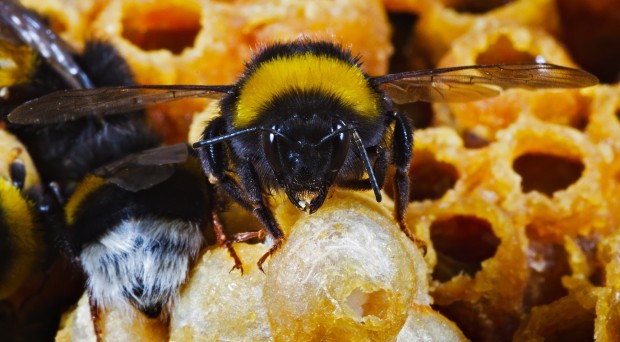
Bumblebees are charismatic insects, and many of us living in temperate regions associate them with the onset of spring. What many do not realize though is that bumblebees are an integral part of the wild pollinator community, critical for the maintenance of flowering plants in natural systems.
Bumblebees are also vital for agriculture and a world without them and other pollinators would drastically influence our food availability. Unique buzz-pollination makes bumblebees the most efficient pollinators of crops such as tomatoes. Yet, the status of many bumblebee species is of concern, with population declines frequently observed in recent years.
Touted drivers behind declines include habitat loss, biologically active chemicals like pesticides, and diseases. Genomic studies of bumblebees can uncover their susceptibilities to some of these threats on a gene-level.
With an extensive network of colleagues we published two papers in Genome Biology exploring the genomes of two key bumblebee species, the Common Eastern Bumblebee from North America and the European Buff-tailed Bumblebee.
The first paper presents the genome sequences and general analyzes of a number of aspects relevant for understanding the genomic basis of bumblebee biology. The second paper focuses on the immune genes in the genomes, which is key to our understanding of how they interact with diseases.
In addition to conservation, bumblebees are fascinating for their social lives, and have been the focus of many studies on social behavior and evolution. A gradient of sociality exists across the many bee species, ranging from solitary individuals like leafcutting bees, to to the large, highly social, long-lived colonies of honeybees.
Bumblebees are, in a way, intermediate between the solitary bees and highly eusocial honeybees. Most species of bumblebees do form colonies with a division of labor between reproductive queens and working castes, but colonies are smaller and annually established by individual queens.
The cooperation between the Queen and her worker offspring in bumblebees appears more fragile, with conflict ensuing at certain times in the colony cycle. Thus, bumblebees are in a unique position to explore the adaptations to sociality.
The two published papers explored the bumblebee genomes and compared them to honeybees, solitary bees, and other model insects. The genome paper, the result of a large international collaboration led by Dr. Ben Sadd of Illinois State University, Dr. Paul Schmid-Hempel of Switzerland’s ETH Zürich, and Dr. Kim Worley of the Baylor College of Medicine, investigates genes involved in several aspects key to the biology of bumblebees including behavior, neurophysiology, development, sex determination and venom production.
Much like honeybees, the detoxification genes of bumblebees are reduced compared to other sequenced insects. This is likely to influence their ability to cope with external toxins, such as agricultural pesticides. Compared to honeybees, based on their gene repertoire bumblebees unexpectedly emphasize gustation over olfaction. This chemosensory difference is important for ecological interactions between the bees and their environment.
Surprisingly, the complement of most genes thought to be involved sociality is very similar between bumblebees and the more advanced social honeybees, raising the question of what drives the key social differences. A clue comes from looking at the microRNA (miRNA) of the bumblebees.
miRNAs are short non-coding RNAs that tune gene expression of other genes. They were previously suggested to regulate social behavior in honeybees. The miRNA profile of bumblebees is strikingly distinct from that of honeybees. These findings suggest the evolution of advanced societies in the bees didn’t occur through large leaps due to mass genomic changes, but rather through subtle changes across many genes and processes that are likely tuned by mediators of gene expression.
The immune gene companion study, led by Dr. Seth Barribeau of the ETH Zürich and East Carolina University, made some exciting findings regarding bee immune system evolution. A surprising feature of previous social insect genomes is that despite an apparent heightened risk of disease due to social living in dense and highly related groups, honeybees and social ants have relatively few immune genes.
This could be because behavioral adaptations in social species help protect against infection, which rendered many immune genes of solitary species unnecessary. However, we found that despite the fundamental differences between solitary leaf-cutter bees, bumblebees and honeybees, the genes of their immune systems are largely the same.
This suggests that highly social honeybees did not lose functional immune genes, but rather that an ancestor of these social and solitary bees had fewer immune genes.
While the different bees have similar immune genes, on a finer scale these genes show signs of evolving differently in the different groups, suggesting different pressures from diseases in the evolutionary histories of these bee species.
Some genes such as antimicrobial peptides, directly responsible for killing invading pathogens, are more rapidly evolving in honeybees than in bumblebees. Antiviral genes are evolving quickly in both honeybees and bumblebees compared to the solitary bee, but individual genes show different patterns.
Bumblebees, once known as humble bees, have long been and continue to be an object of fascination and a model system for many areas of biology. The published genomes and analyzes are a further step in this course. These genomic advances should herald a new era of studies facilitating further important insights into bumblebees and insect societies.
Seth Barribeau & Dr Ben Sadd
Dr. Ben Sadd is an Assistant Professor of Infectious Disease Ecology, working at Illinois State University. He studies interactions between hosts and diseases from an evolutionary ecology perspective. Dr. Sadd works on general concepts, but uses mainly insects as study systems, and primarily bumblebees and their parasites.
Latest posts by Seth Barribeau & Dr Ben Sadd (see all)
- Disease, drugs and a social life: insights from humble bee genomes - 24th April 2015
What an interesting article! I find bumblebees intriguing.
I have recently designed a nest for bumblebees and it is in a competition with other university business concepts, Would really appreciate a vote to help save the bumblebees and get the design to market!
https://www.santanderuniversities.co.uk/enterprise/win/60-second-pitch/vote-now?t=1430495216